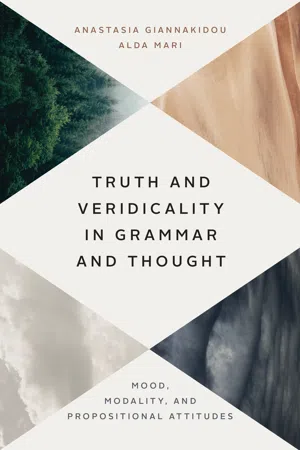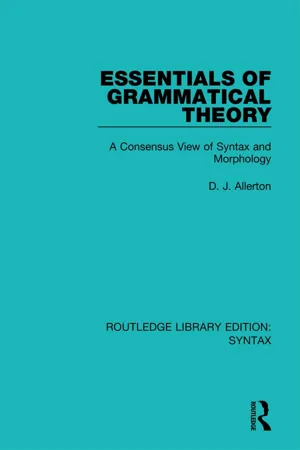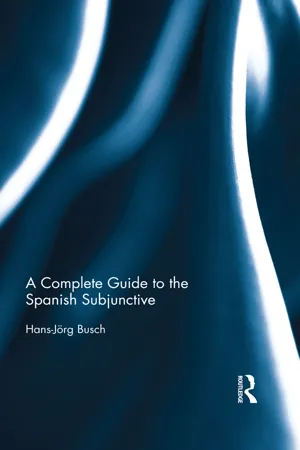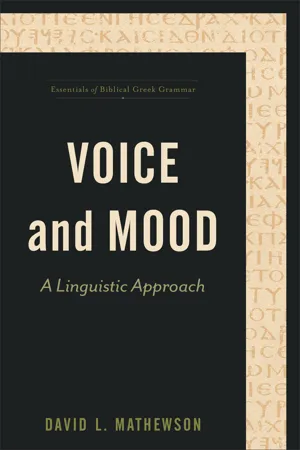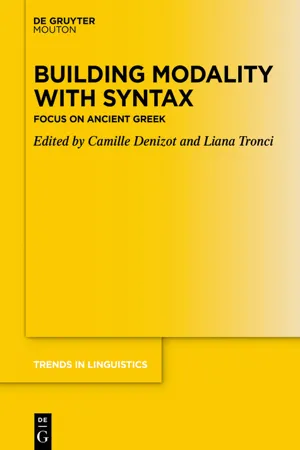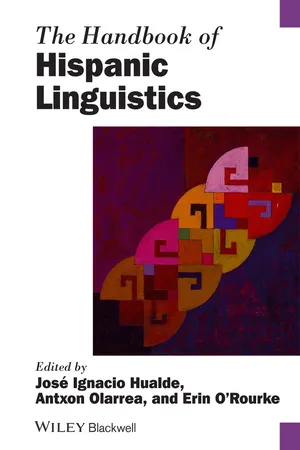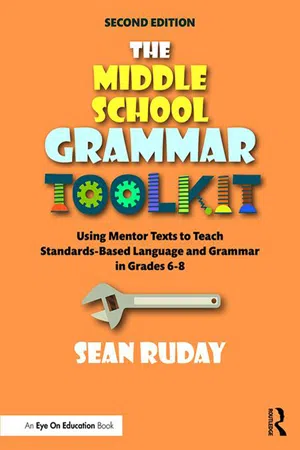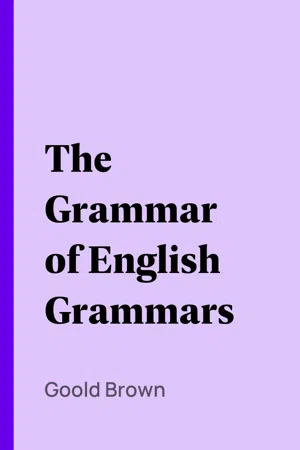Languages & Linguistics
Grammatical Mood
Grammatical mood refers to the form of a verb that shows the speaker's attitude toward the action or state expressed. There are typically three moods: indicative (states a fact or asks a question), imperative (gives a command or request), and subjunctive (expresses a hypothetical or unreal situation). The mood of a verb can greatly impact the meaning and tone of a sentence.
Written by Perlego with AI-assistance
8 Key excerpts on "Grammatical Mood"
- eBook - ePub
Truth and Veridicality in Grammar and Thought
Mood, Modality, and Propositional Attitudes
- Anastasia Giannakidou, Alda Mari(Authors)
- 2021(Publication Date)
- University of Chicago Press(Publisher)
Since analytical contemplation is mediated by language, an additional layer of issues arises about language, specifically about whether and how language mediates to express thinking about the world. Natural languages vary in the vocabulary, form, and grammatical categories they realize; yet in addressing the question of language and thought, most Continental philosophy overlooks this striking variation and almost exclusively focuses on English. This focus affects negatively the set of data deemed relevant for analysis, and in effect diminishes, not to say dismisses, the role of linguistic diversity in revealing aspects of the logic needed in order to handle accurately and successfully the central questions of truth and knowledge.In this book, we will explore the interaction between truth, knowledge, and veridicality as they interact in the grammatical phenomenon of mood choice (subjunctive, indicative) in European languages. Our main illustrators will be Standard Modern Greek and the Romance language family, with specific emphasis on Italian and French. Mood choice is a multidimensional phenomenon, as we shall see, involving interactions between syntax, semantics, and pragmatics; and raises a number of issues that are literally invisible if we pay attention only to English simply because Modern English lacks the morphological category of mood in embedded clauses. Despite this absence, terms such as “subjunctive” and “indicative” continue to be routinely used by philosophers, e.g., in the discussion of English conditionals, often misleading us to think that we are dealing with a mood phenomenon. (We are not. Indicative and subjunctive conditionals are really about tense.)On the other hand, mood has been studied by traditional grammarians as a mainly morphosyntactic phenomenon, and in this tradition very little attention is paid to the semantics of propositional attitude verbs which are responsible for regulating mood choice. Traditional analyses are mostly interested in taxonomies and labeling of the verbal classes, with reference to realis and irrealis to cover the semantics of modal verbs (must, may, can etc.) and propositional attitude verbs (such as know, believe, remember, want, persuade and the like). The intuition is that somehow the indicative signals that the sentence is true (realis) , whereas the subjunctive signals that the sentence is untrue (irrealis) , thus implying that language directly accesses reality. This, however, as we will show, is an unwarranted assumption. Language, it will turn out, mostly encodes subjective representations of truth and reality construed by linguistic agents, i.e., the speaker or the subject of the attitude verb. In forming these representations, linguistic agents build veridicality stances - eBook - ePub
Essentials of Grammatical Theory
A Consensus View of Syntax and Morphology
- D. J. Allerton(Author)
- 2016(Publication Date)
- Routledge(Publisher)
ur) when the person punished is in subject position (in the nominative case). Ancient Greek has a third “middle” voice with a partly reflexive, partly impersonal, function, though it is not fully differentiated from the passive. Languages that do not allow the reformulation of a sentence through a voice transformation cannot be said to have a category of voice in the full sense. In Hindi, for instance, where the transitive verb has an active-looking construction in the present but a passive-looking one in the past, these must be looked upon as variants. Similarly, ergative languages like Basque and Eskimo, which allow a nominative noun phrase both alone as a “patient” subject and in a transitive sentence as “patient” object, cannot be said to have different voices because the verb form is invariable. But clearly verbal voice and nominal case are closely linked, and both have a sentential role.The traditional grammatical category of MOOD , which is attached to the verb but seems to make a direct contribution to the character of the whole sentence, appears to have three related strands. The first, which we might term “modality”, refers to the attitude the speaker takes towards the reality or truth of what he is asserting. The speaker may, instead of simply asserting what will or did happen, prefer to suggest what could happen or throw doubt on what might (have) happen(ed). Turkish, for instance, has a verbal suffix -ebill-abil for potentiality and a suffix -(i)miş (subject to vocal harmony) for dubitative modality, aspects of meaning that might be expressed in English through modal auxiliary verbs like can, may, must. Finnish has a special negative conjugation of the verb, whereas most languages simply have an independent particle. A second strand, which we might term “mode”, relates to the kind of utterance used by the speaker, whether he is simply asserting (indicative mood), or perhaps asking a question (interrogative mood) or issuing a command (imperative mood) or expressing a wish (optative mood). Many languages have a special verb form for the imperative, and some, like Turkish, have a verbal modification for the interrogative (in Turkish the suffix -me/ma). The final strand is what we might term “mood proper” in the sense of verbal categories relating to the grammatical status of the sentence. In this dimension an independent sentence is declarative (indicative), but an embedded subordinate clause may require a different form, perhaps the subjunctive, as in the Romance languages. An embedded sentence may have special non-finite forms such as infinitive, participle or gerund.The verbal category of TENSE - Hans-Jorg Busch(Author)
- 2017(Publication Date)
- Routledge(Publisher)
The function or systematic grammatical meaning of the indicative, subjunctive, and imperative moods in SpanishBy defining moods as the formal and systematic manifestations of modality, they are characterized as grammatical structures with a general modal meaning. This meaning cannot be explained in philosophical, semantic or pragmatic terms, but as a notion that corresponds to all the specific systematic manifestation in the language. Neither can it be defined as triggered by the meaning of other elements or just as the product of distribution rules.
The basic mood in Spanish is the indicative. Its verb endings and uses distinguish it from the subjunctive and the imperative.7.1 The formal distinction between indicative and subjunctive in SpanishThe formal distinction between the present indicative and subjunctive is minimal. It is just based on the distinction between the phonemes versus allophones /a/, /e/ and /i/. The same goes for the difference between the imperfect and the imperfect subjunctive (past subjunctive) of regular -ar verbs that are only distinguished by the phonemes [b] and [r]. This is similar to how we use phonemes to distinguish words with different meaning, such as fAn and fUn, bOOt and bOAt, haPPy and HaRRy , etc.Therefore, it is important for teachers to train their students to hear the phonetic difference between [a] and [e] and to point out the importance of this phonological distinction in the Spanish language.The subjunctive paradigm is in many ways more limited and restricted when compared to the indicative:- There are only two simple subjunctive conjugations – if we ignore the differences between the two imperfect subjunctive forms hablara/hablase :1 the present and past subjunctive. However, there are five simple indicative conjugations: the present, preterit, imperfect, future, conditional indicative.2 (We can neglect the analytic forms consisting of haber
- eBook - ePub
Voice and Mood (Essentials of Biblical Greek Grammar)
A Linguistic Approach
- Mathewson, David L., Porter, Stanley E.(Authors)
- 2021(Publication Date)
- Baker Academic(Publisher)
The assertive attitude is grammaticalized by the indicative mood form, and the nonassertive is grammaticalized by a series of nonindicative mood forms, labeled by grammars as subjunctive, optative, and imperative moods. Unlike in English, in Greek the indicative mood is indicated not by a configuration of lexical items in a particular order but by a set of verbal endings. As already seen above, the indicative mood grammaticalizes the attitudinal semantic feature of assertion and is used to indicate the author’s intention to portray the action as reality (whether or not this corresponds to a factual basis in reality). The indicative mood largely indicates epistemic modality, making a judgment on the factual status of the proposition. However, unlike some language systems, 2 Greek does not indicate the evidence or reasons or manifest an evidential modality through its choice of formal endings, or levels of certainty or assertiveness, only manifesting one set of formal endings for the indicative mood. Greek grammaticalizes nonindicative or nonassertive attitude through a system of choices among three moods, which will be further developed below. It will be demonstrated that the subjunctive mood grammaticalizes the semantic feature of projection or visualization. The optative mood overlaps semantically with the subjunctive mood by indicating projection or visualization but seems to carry the additional semantic feature of contingency. 3 That is, the action is seen as more vague, hesitant, and contingent on other factors. Finally, the imperative mood grammaticalizes the semantic feature of direction. It can be seen as the furthest removed from assertion in relationship to reality, in that it only directs an action - eBook - ePub
Building Modality with Syntax
Focus on Ancient Greek
- Camille Denizot, Liana Tronci, Camille Denizot, Liana Tronci(Authors)
- 2023(Publication Date)
- De Gruyter Mouton(Publisher)
modality to express all the contents of the domain.Modality is not a simple category that pairs a form, the verbal mood, with a content, the modality content, in a single way. It is a category whose morphs are not exclusively verbal moods. There are other markers, such as modality adverbs, modal verbs, and lexical items, and there are also some grammatical categories which systematically interact with modality contents, such as tense, aspect, and evidentiality.2 On the level of content, the issue is even more complicated. At least three different domains must be differentiated: epistemic modality, deontic modality, and speech act modality.3 Epistemic modality incorporates realis, irrealis, possibility, and probability. Deontic modality considers obligation and necessity. Sentence-type modality includes the conventionalised connection between types of sentences, verbal moods, and the typical illocutionary force that the sentence type conveys: declarative, directive, interrogative, and expressive (Nikolaeva 2016 : 69). Bybee, Perkins and Pagliuca (1994: 176–181) refer to these terms as agent-oriented modality, speaker-oriented modality, epistemic modality, and subordinating modality. Agent-oriented modality includes obligation, necessity, ability and desire. Speaker-oriented modality includes imperative, prohibitive, optative, hortative, admonitive, and permissive constructions.Consequently, the modality content of a particular instance is produced by the interaction of the content expressed by the verbal mood, additional modality content rendered by sentence adverbs, and elements with modality content, such as tenses, plus the modality content expressed by the type of sentence. Moreover, this shortlist, including moods, modal verbs, adverbs, tenses, and sentence types, does not exhaust the inventory of elements with modality functions or, even better, that of elements interacting in one of the modality domains (Revuelta Puigdollers 2017: 18–22; cf. also Ruiz Yamuza 2014). Furthermore, as stated by Denizot and Tronci (this volume), the way they interact and influence each other to build modal meanings has yet to be explored. - eBook - ePub
- José Ignacio Hualde, Antxon Olarrea, Erin O'Rourke, José Ignacio Hualde, Antxon Olarrea, Erin O'Rourke(Authors)
- 2012(Publication Date)
- Wiley-Blackwell(Publisher)
19
Mood: Indicative vs. Subjunctive
IGNACIO BOSQUE1 Introduction: syntactic contexts for moods
Moods constitute a manifestation of modality. This category reflects the speaker’s attitude towards propositional contents, more specifically the various forms in which statements are interpreted under the influence of semantic environments, whether hypothetical or real. Moods are verbal inflections reflecting modality. They may directly encode grammatical differences related to speech acts, as in the subjunctive form tenga in ¡Tenga un buen día! ‘Have a nice day!,’ as opposed to the indicative tiene in Tiene un buen día ‘S/he is having a nice day.’ In many cases, moods are induced or triggered by various grammatical categories in restricted syntactic contexts, for example the preposition sin ‘without’ in sin que tú lo {supieras/*sabías} ‘without you {knowing-SUBJ./knowing-IND.}.’There exists an abundant theoretical literature on the Spanish verbal moods, written in several frameworks, as well as many traditional and descriptive studies on this topic. Overviews may be found in Lleó (1979), Manteca Alonso-Cortés (1981), Borrego et. al. (1986), Bosque (1990), Porto Dapena (1991), and Ahern (2009), among others. Extensive chapters are devoted to the description of moods in recent grammars of Spanish. See Ridruejo (1999), Pérez Saldanya (1999) and RAE-ASALE (2009: ch. 25). General presentations of the subjunctive mood in current theoretical linguistics may be found in Portner (1999), Quer (2005), and Laca (2010). Studies on Spanish moods from pragmatic, functional, or discourse-oriented perspectives include Lunn (1989, 1995), Mejías-Bikandi (1994), Maldonado (1995), Gregory (2001), Haverkate (2002), and Travis (2003). - eBook - ePub
The Middle School Grammar Toolkit
Using Mentor Texts to Teach Standards-Based Language and Grammar in Grades 6–8
- Sean Ruday(Author)
- 2020(Publication Date)
- Routledge(Publisher)
The final step of this instructional process is to ask students to reflect on the importance of understanding and purposefully using verb moods. To facilitate this reflection, I recommend posting the following questions on the board and asking students to discuss them in small groups:- Why is it important that writers understand all of the verb moods?
- How can using the correct verb mood impact a piece of writing?
After the students have discussed these questions in small groups, I ask volunteers to share their thoughts with the whole class. During a recent discussion of these questions, one eighth grader explained,If you don’t use the correct mood, your writing won’t be as good. Like, if you want to tell someone what to do, you need to use the imperative. If you don’t, your writing won’t be as good because you didn’t use the mood that goes with what you’re saying.This response reveals this student’s awareness of the relationship between verb moods and effective writing. As this student suggests, using verb moods that align with a particular message allows authors to make their points as effectively as possible.Final Thoughts on Forming and Using Verbs in the Indicative, Imperative, Interrogative, Conditional, and Subjunctive Moods
- Common Core Language Standard 8.1 calls for students to “Form and use verbs in the indicative, imperative, interrogative, conditional, and subjunctive mood” (Common Core State Standards Initiative, 2010).
- Below are explanations of each of these five verb moods:
- The indicative mood is used to make a statement.
- The imperative mood is used to make a command.
- The interrogative mood is used to ask a question.
- The conditional mood is used to express some condition of possibility, obligation, or necessity. Sentences in the conditional mood contain modal auxiliaries, such as could , may , might , would , and should
- eBook - ePub
- Goold Brown(Author)
- 2004(Publication Date)
- Perlego(Publisher)
MOODS.
Moods [229] are different forms of the verb, each of which expresses the being, action, or passion, in some particular manner.There are five moods; the Infinitive, the Indicative, the Potential, the Subjunctive, and the Imperative.The Infinitive mood is that form of the verb, which expresses the being, action, or passion, in an unlimited manner, and without person or number: as, "To die,—to sleep;—To sleep!—perchance, to dream!"The Indicative mood is that form of the verb, which simply indicates or declares a thing: as, I write; you know: or asks a question; as, "Do you know?"—"Know ye not?"The Potential mood is that form of the verb which expresses the power, liberty, possibility, or necessity, of the being, action, or passion: as, "I can walk; he may ride; we must go."The Subjunctive mood is that form of the verb, which represents the being, action, or passion, as conditional, doubtful, and contingent: as, "If thou go, see that thou offend not."—"See thou do it not."—Rev., xix, 10.The Imperative mood is that form of the verb which is used in commanding, exhorting, entreating, or permitting: as, "Depart thou."—"Be comforted."—"Forgive me."—"Go in peace."OBSERVATIONS.
OBS. 1.—The Infinitive mood is so called in opposition to the other moods, in which the verb is said to be finite. In all the other moods, the verb has a strict connexion, and necessary agreement in person and number, with some subject or nominative, expressed or understood; but the infinitive is the mere verb, without any such agreement, and has no power of completing sense with a noun. In the nature of things, however, all being, action, or passion, not contemplated abstractly as a thing, belongs to something that is, or acts, or is acted upon. Accordingly infinitives have, in most instances, a reference to some subject of this kind; though their grammatical dependence connects them more frequently with some other term. The infinitive mood, in English, is distinguished by the preposition to; which, with a few exceptions, immediately precedes it, and may be said to govern it. In dictionaries, and grammars, to is often used as a mere index, to distinguish verbs from the other parts of speech. But this little word has no more claim to be ranked as a part of the verb, than has the conjunction if, which is the sign of the subjunctive. It is the nature of a preposition, to show the relation of different things, thoughts, or words, to each other; and this "sign of the infinitive" may well be pursued separately as a preposition, since in most instances it manifestly shows the relation between the infinitive verb and some other term. Besides, by most of our grammarians, the present tense of the infinitive mood is declared to be the radical form
Index pages curate the most relevant extracts from our library of academic textbooks. They’ve been created using an in-house natural language model (NLM), each adding context and meaning to key research topics.
Explore more topic indexes
Explore more topic indexes
1 of 6
Explore more topic indexes
1 of 4
